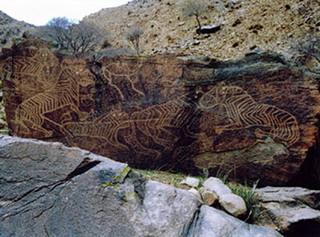Source: Inner Mongolia News
07-23-2007 18:45
 |
As early as the 5th century, the rock paintings of Yinshan Mountains were found by Li Daoyuan, a geologist of the Northern Wei Dynasty. A detailed account of his findings was given in his renowned Work-Commentary on the Waterways Classic. This is the earliest record of the rock paintings of Yinshan Mountains in the world. It was in 1976 that China started a comprehensive survey of the rock paintigns. From then on, large numbers of experts, scholars and tourists have carried out studies of these paintings and paid visits to Bayannur League, more than ten thousand rock paintings have been discovered, and nearly one thousand of them have been photographed or copied. These rock paintings not only reflect the beliefs,aesthetic standards and world outlook of the ancient in habitations in Yinshan Mountains areas, but also present a truthful picture of their nomadic life.
The rock paintings of Yinshan Mountains scatterover a wide area. The densest concentration is on the Heishan Mount of Dilihari Mountains to the south of Wulate Middle Banner, Bayannur League, Inner Mongolia, stretching over five kilometers from the east to the west. Over one thousand rock paintings can be found in this place alone. These rock paintings, together with the large numbers of rock paintings found on the southernhillside and the mountaintop not too far away to the northeast of the Dilihari Mount, constitute a concentration area of rock paintings. On the Wayaogou Northern Mount about 8 kilometers to the southwest of the Dilihari Mount, paintings can be found at the intervals of 2 meters, 10 meters or longer, amounting to a total number of more than 900 paintings. Next in density is the black rocks in the mountainous areas of North Tuolin Valley, Dengkou County, where rock paintings are found at the intervals of2-3meters ingeneral and 10 meters at the most, numbering more than 500 pieces in total.
One of the two densest concentrations of rock painting group is a cliff facing the north in Molehetu Valley, with about 80 head portraits clustered within an area approximately 50 meters in width and 20meters in height. The other one is a cliff facing the west in the middle of Geheshangde Valley, consisting of 50 individual drawings within an area approximately 5 meters in width and 15 meters in height.
The rock painting with the largest sizeis the square painting drawn on the rocks by the western mouth of the Daba Valley, Urad Rear Banner, which covers an area of about 400 sq meters and ranks among the key preserved cultural relics of Inner Mongolia Autonomous Region.
